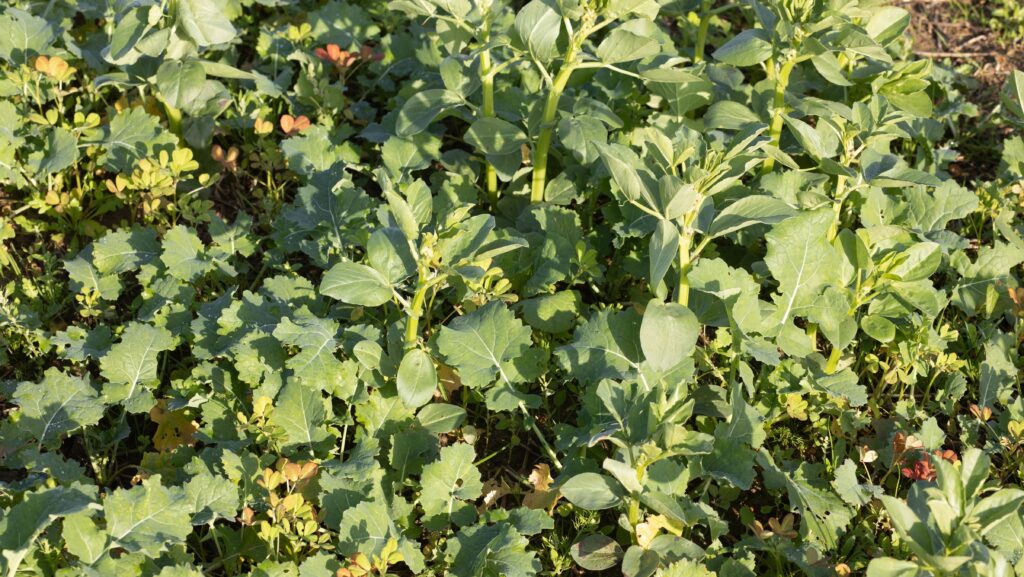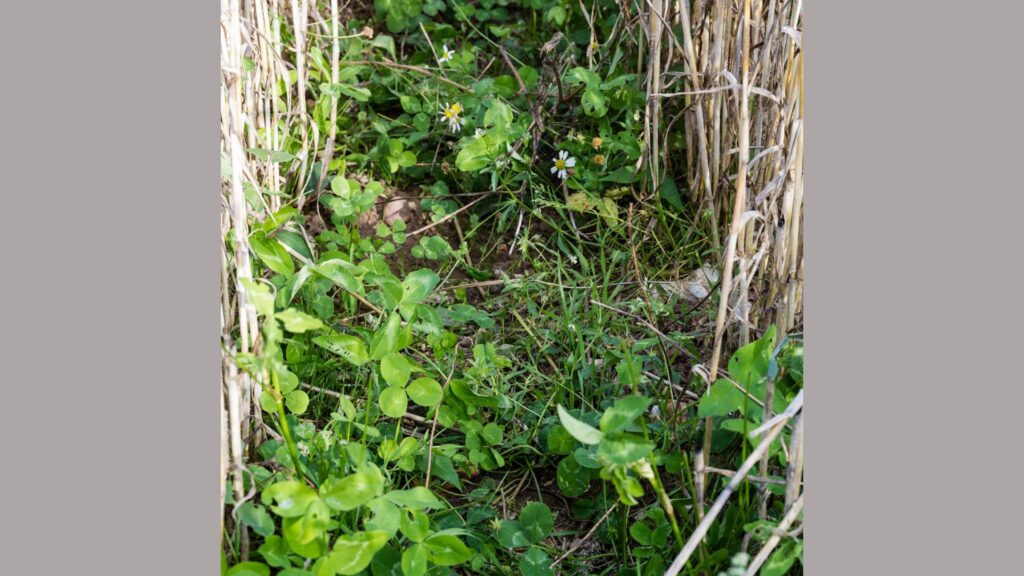How to get the best out of IPM3 companion cropping in SFI
 © Tim Scrivener
© Tim Scrivener
Companion cropping is perhaps one of the easier options to include in Sustainable Farming Incentive (SFI) agreements, particularly if you’re growing oilseed rape or perhaps maize, or for an end market, such as Wildfarmed that specifies bi-cropping.
Defra’s definition of a companion crop is one that grows with the main arable crop with the purpose of either acting as a trap for pests or suppressing weeds; providing habitat for birds and invertebrates, including pollinators and natural pest predators; managing nutrient efficiency or protecting soil and improving its condition.
See also: How to achieve success with IPM2 flower-rich margins in SFI
The companion doesn’t have to be present for the full growing period of the arable crop if it is managed in a way that will achieve the action’s aim and purposes.
Indeed, for Oakbank’s director, Ian Gould, a companion crop should be thought of as something that doesn’t get harvested with the cash crop, although Defra’s definition for SFI allows it.
What is a companion crop?
“A companion crop is something that provides a service to the cash crop or to soil and the wider environment, whether that is helping the cash crop get established, battling pests or diseases, or delivering soil health benefits outside of a direct benefit to the crop it’s grown with,” he says.
With a payment of £55/ha, many farmers will simply look for a companion that costs less than the payment that won’t affect the cash crop in any way.
And while that might mean the hidden value to soil health or other benefit from the companion is not fully considered, any negative impact on yields of the cash crop will quickly turn a profit into a loss, he notes.
“So you’re looking for a companion that has a benefit or at least is neutral on the cash crop.”
In oilseed rape that is relatively straightforward, with companions of species such as buckwheat, berseem clover and fenugreek, while nowhere close to being a silver bullet, having shown in trials to help OSR become established, while helping reduce the impact of cabbage stem flea beetle and pigeons.
“It’s part of a set of tools to try with oilseed rape, although not the only one.”
That makes it a relatively simple choice for those growing oilseed rape to include in SFI applications.
In wheat, the decision for most growers will be complicated by the need to use pre-emergence herbicides for grassweed control and not limit yield potential.
“That immediately limits the species you can use as a companion as most will be taken out by the pre-emergence herbicide,” Ian says.
Beans and linseed
Oakbank trials in conjunction with part-owner Velcourt have narrowed down the options to just beans and linseed.
“We’ve tried them with most pre-emergence herbicides and they seem to come through okay.”
Beans will grow well when soil temperatures reduce, produce reasonable amounts of nitrogen and are a relatively benign partner for wheat, Ian adds.
“But to plant them at the same time as wheat requires a specialist drill that can cope with two different seed sizes and depths.
“In practice, most will use this option when they are planting wheat into a bean stubble, with the bean volunteers acting as the companion, which works well in our experience.”
Establishing linseed with winter wheat is more straightforward, with it being possible to mix linseed and wheat seed in a single hopper, if a dual hopper drill is not available.
Drilling date is important, particularly on heavier soil, with linseed less likely to be successful after the early part of October, Ian says.
“Above ground, linseed is a fairly little spindly crop so doesn’t compete too much for light and other resources, while below ground it has good deep vertical roots that don’t spread out too much, but do a good job of soil conditioning, while not competing for resources in the same place as the wheat.”
Keep wheat seed rates the same when drilling with a companion, he advises, while dropping the companion seed to 15-20% of normal. “So for linseed something like 7-8 kg/ha.”
Both linseed and wheat will be removed with spring herbicides that most growers will commonly use.
Linseed might also work as a companion for winter barley, although the competitive nature of winter barley makes it difficult to add a companion successfully to some extent, Ian suggests.
Other popular companion crop options, where both crops might be taken to harvest, include beans with either oats or oilseed rape, and peas and oats.
What about living mulches?
Undersowing a companion crop to form a living mulch under the cash crop is another potential way of meeting the SFI criteria.
The most obvious example of this is undersowing grass, usually a fast-growing ryegrass, under maize to help protect against soil erosion following harvest.
That typically requires an inter-row drill to sow the grass between the rows once the maize has established, both to allow early weed control and because maize doesn’t respond well to competition.
A relatively small number of growers have also experimented with living mulches of clover under cereals and oilseed rape, providing some nitrogen fixation, weed suppression and improved soil health.
Although not easy to get right, it can be successful, says Oakbank’s Ian Gould. It won’t fit on every farm due to the compromises on herbicides needed.
Successfully established and managed, a living mulch can last for multiple seasons.
“We’ve had wheat that’s yielded 11.7t/ha with a living mulch, so it doesn’t have to be a low input, low output system,” he adds.
“But generally it fits where farmers have other objectives such as livestock integration.”
It’s also useful in fields where frequent waterlogging is challenging soil structure and you’re looking to change the way soil deals with water, he suggests. “That’s how we got started on one farm, where the root mass from the clover has improved soil structure to allow water to penetrate better.”
White clover

© Blackthorn Arable
He suggests using exclusively small-leaved white clover in this situation.
Once established it tolerates a low level of glyphosate which is still sufficient to kill any emerging grassweeds, while the small leaved nature of the clover means it doesn’t create too much competition for the cash crop by clambering up stems.
“It probably does still have a competitive effect on the wheat, as the root mass is competing for moisture and nutrients, but, on average, there seems to be a benefit.
“The downside is this type of clover produces less biomass for grazing.”
Establishing the clover is best done in warm conditions, so either with oilseed rape or in the spring with spring beans, spring wheat or for likely best results alone, before then drilling into it in the autumn.
Other crops such as winter wheat, winter barley or spring barley are either too competitive or drilled too late for the clover to establish to get through winter.
With oilseed rape, clover seed rates can be as low as 4kg/ha, while with spring crops, Ian suggests 8-10kg/ha, reducing to 6-8kg/ha if drilled alone.
Avoid fields with thistle, cranesbill and dock problems, as weed control is virtually impossible without killing the clover.
“If you’re establishing it with oilseed rape, while Kerb (propyzamide) is fine to use, Astrokerb (propyzamide + aminopyralid) will kill the clover,” Ian warns.
Grazing the clover post-harvest is helpful for reducing the clover canopy before drilling the next crop and thinning it for low rates of glyphosate to take out grassweeds.
While the clover can seemingly disappear in hot, dry summers, Ian says it often comes back in the autumn when rain returns.
“But don’t subsoil in those high stress conditions – that’s a really effective way to kill it.”
